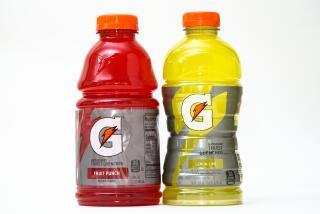Proposed soda ban likely to backfire, study finds
- Share via
After New York Mayor Michael R. Bloomberg unveiled his plan to ban the sale of sodas larger than 16 ounces, comedian Jon Stewart complained that the proposal “combines the draconian government overreach people love with the probable lack of results they expect.”
It turns out the “Daily Show” host was on to something.
New research shows that prompting beverage makers to sell sodas in smaller packages and bundle them as a single unit actually encourages consumers to buy more soda — and gulp down more calories — than they would have consumed without the ban.
Not only would thirsty people drink more, but circumventing the big-drink ban by offering consumers bundles of smaller drinks also would mean more revenue for the beverage purveyors, according to a study published Wednesday in the journal PLOS ONE. The sales boost would probably offset the added cost of producing more cups, lids and straws to hold those extra drinks, the researchers found.
The results reveal “a potential unintended consequence that may need to be considered in future policymaking,” wrote the study authors, psychologists from UC San Diego.
The findings come a month after a New York judge struck down a bid by New York City’s health department to halt the sale of super-sized soft drinks at restaurants, movie theaters and sports venues across the city, calling the proposed measure “arbitrary and capricious.”
The effort’s legal failure sparked a round of soul-searching by public health officials, whose anti-obesity efforts have focused heavily on reducing Americans’ consumption of soft drinks and other sweetened beverages laden with sugar and calories.
The PLOS ONE study explores a logical response by vendors faced with a ban on selling beverages in containers larger than 16 ounces: to offer “bundles” of fountain-style drinks in smaller containers at discounted prices.
The researchers recruited 100 undergraduate students at UC San Diego and set up a mock concession stand offering popcorn, pizza and an array of beverage choices packaged in single-serving cups and in bundles of cups.
In one setup, the researchers offered a full-service menu with 16-ounce, 24-ounce and 32-ounce drinks for $1.59, $1.79 and $1.99, respectively. In another, students could buy a single 16-ounce soda for $1.59, two 12-ounce sodas for $1.79, or two 16-ounce sodas for $1.99. There was also a “no-bundle” menu, offering only a 16-ounce drink for $1.59.
When ordering off the bundled menu, the subjects bought more ounces of soda than in either of the other two cases. They were also less likely to skip a drink when bundles were available — only 16% made that choice, compared with 21% who opted to go beverage-free when faced with the full-service menu and 38% who did so when the only option was the 16-ounce drink.
In addition, the vendor’s revenue was significantly higher when the bundled drinks were offered, the researchers found.
David Just, a professor of behavioral economics at Cornell University’s Dyson School of Applied Economics and Management, said the findings fit with typical buyer and seller behavior, and underscore the hidden hazards of regulatory actions that may be seen by consumers as restrictive.
“Most people getting ready to buy soda will go for the regular size,” said Just, who was not involved in the study. But when people want a large soda and they are prevented from buying it, he said, “they’re going to display what we call reactance — a rebelliousness, a determination to circumvent this policy, an attitude of ‘I’ll show them.’ And the people selling the soda are all too willing to comply.”
When restrictions are the result of quiet negotiations and voluntary actions by vendors, consumer reactance is not such a threat, Just said. “But when it’s really upfront and in your face, that can generate that pushback,” he added.






